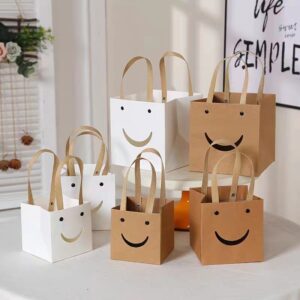
4 Common Types of Paper Materials for Paper Bowl Cup & Their Differences
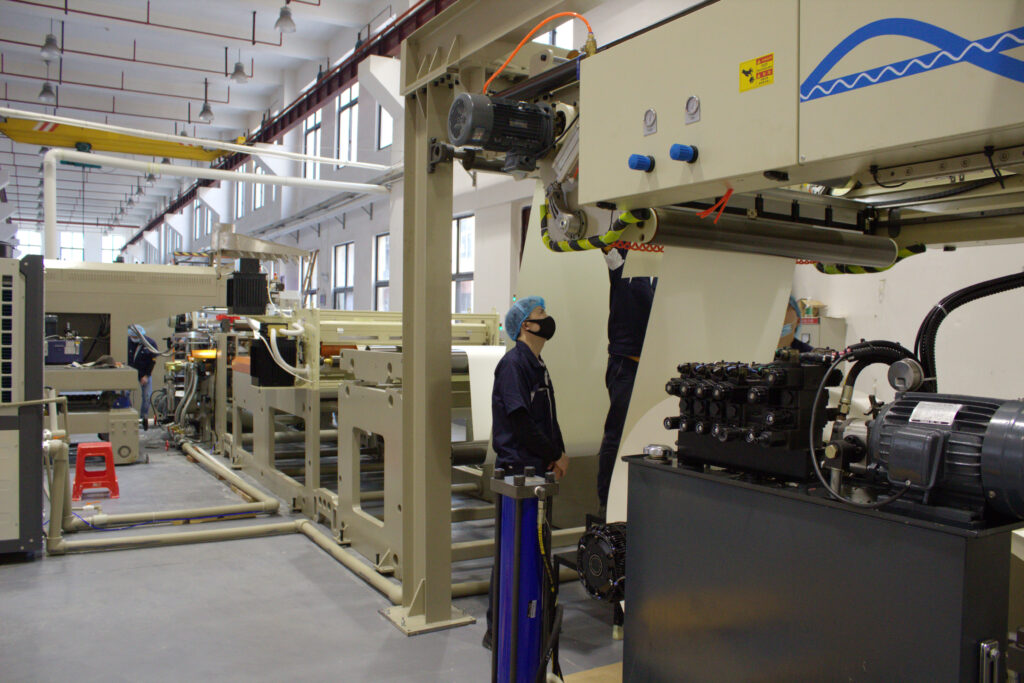
Paper is a basic raw material used to manufacture paper bowls as well as its lamination (PE Film, PP, PLA film, and Water-base barrier coating). With modern paper pulp manufacture developed, a variety of paper materials is introduced as paper material for making paper bowls and paper cups.
Different Paper materials have a great impact on the thickness, durability and printing effect of paper bowls. In this article, we explore the difference between four common types of paper materials so that you can decide what’s best for your applications
Kraft Paper
As the popular sustainable and most commonly use paper material, kraft paper is ideal for food packaging and catering service. Kraft paper is durable and tear-resistant paperboard. In Germany, kraft means strong.
Thus, the kraft paper is perfect for takeout containers and takeaway services. With its natural brown look, it is timeless fashion to use kraft in eco-friendly paper packaging.
Virgin Kraft paper is a more eco-friendly paper type. During the kraft paper manufacture process, there are almost no bleached and fewer bleaching chemicals.
What is more, the kraft paper is recycled. After it is been recycled, it can be used where there is no requirement on food grade and high tear resistance for example carton box
Advantages of Kraft Paper:
Extreme durability
Eco-friendly
Biodegradable
Natural Beauty
Disadvantages of kraft paper:
Poor Grease & Water Resistant Without lamination
Less a possibility of printing colour
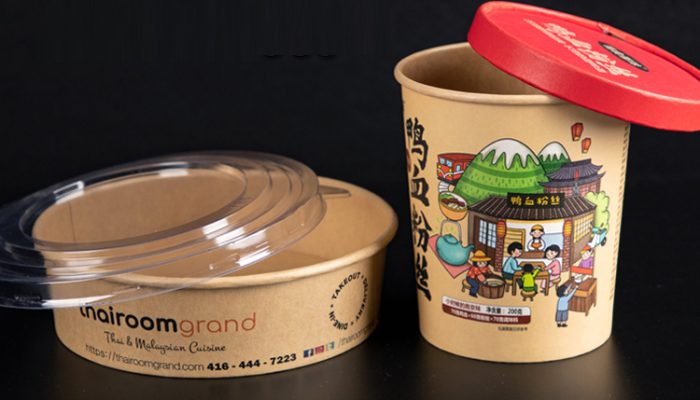
Cupstock Paper(White paper)
Cupstock paper made from renewable resources is a popular solution for food-grade paper material for making paper cups and paper bowls.
It has an excellent smooth surface for printing performance. This makes cupstock the best choice for presenting your brand image.The majority of printing paper bowl use cupstock paper.
It can be applied both in hot and cold food service:
1. One polyethene lamination for hot food(1 pe)
2. two side polyethene laminations for cold food(2 pe).
Besides, due to its smooth surface treatment, Cupstock paper has superior moisture and grease resistance with good lamination.
Advantages of Cupstock Paper:
Outstanding print quality
Good Brightness with glossy lamination
Sustainable and renewable
Food-safe
Great strength
Great grease resistant
Disadvantages of Cupstock Paper:
Logo printing on the surface will be easy been scratched if the printing operation is improper
Some supplier uses a fluorescent whitening agent to reduce the production cost
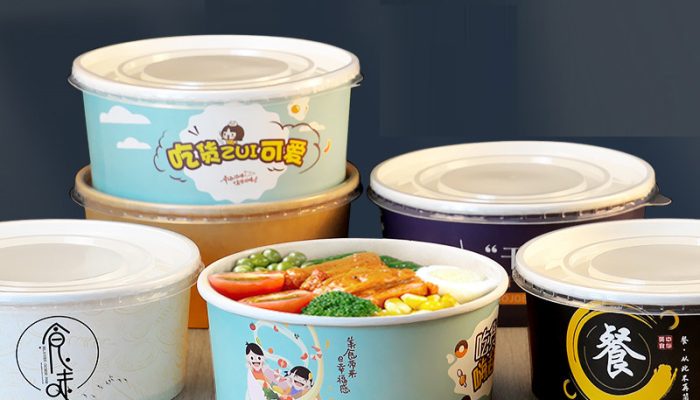
Bamboo Paper
Bamboo paper is totally different paper material which is made from bamboo plants not from wood pulp. As an Emerging Resource, Bamboo is an important non-Wood Fiber paper raw material.
As the bamboo plant grows far much faster than a wood tree (bamboo just needs 3-5 years to reach maturity), bamboo paper is more sustainable and eco-friendlier than kraft and cupstock.
Because of its greater tensile strength (higher than steel), Bamboo paper is more tear resistant than wood paper (kraft and cupstock). The bamboo paper bowl is more durable compared to the paper bowl made of other paper materials.
It is commonly known that bamboo plants have an anti-bacteria substance called” bamboo Kun”. Because of this property, the bamboo paper is antibacterial and antifungal it can bring a longer shelf life of food in the paper bowl.
Advantages of bamboo paper:
Great strength
Sustainable
Antibacterial
Eco-friendly
Lightweight
Food grade
Unbleached
Advantages of bamboo paper:
Less a possibility of printing colour on the natural bamboo colour
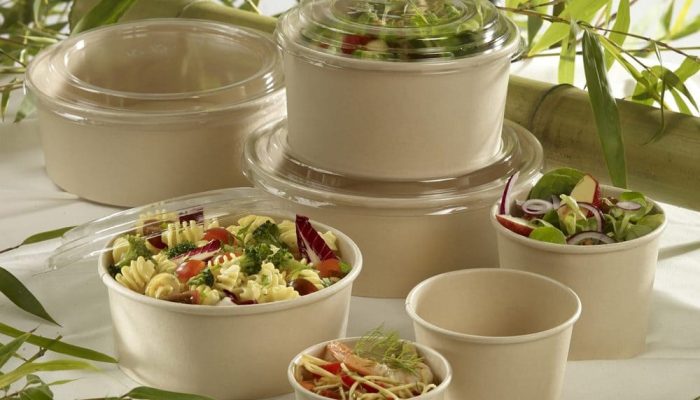
Paper Lamination with Aluminium Foil Film
Paper Laminated Aluminum Foil film offers super good durability for paperboard and can handle high-temperature food or beverage, combined with thick paperboard, and PE lamination.
The Aluminum Foil layer has A great feature is that Aluminum Foil paper bowl is excellent heat resistant and keeps the hot food or liquid warm for a longer time
Paper Laminated with Aluminum Foil film is also able to maintain takeaway food and beverage well without damage from freezing, taste change or smell change during the delivery to the customer’s hands
It can be applied in many hot food services, including instant noodles, ramen bowls, Spicy hot pots or hot soups.
With aluminum foil layer on paper, it can support cooking food in the paper bowl on the induction cooker. It is widely used in the convenience store to cook instant noodle like
Advantages of Paper Laminated with Aluminum Foil
Great strength
Durable
Food grade
Heat-resistant
Good printing quality
Heatable on induction cooker
Disadvantages of Paper Laminated with Aluminum Foil
- Poor Acid Resistance
- Higher price than normal paperboard
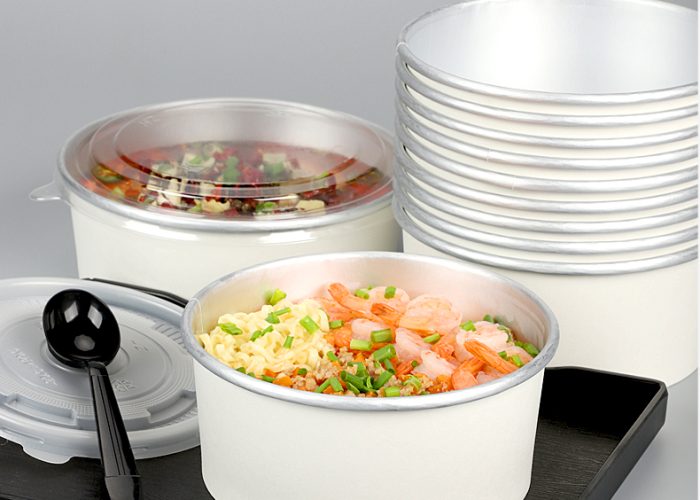
Paper Materials & Advice from YANXIYAN
Still unsure which material is right for your foodservice business? Why not speak to our expert packaging team today?
With over 10 years of experience in the food packaging industry, we have the knowledge needed to advise on the right paper materials and solutions for your needs.
We stock a variety of paper materials including kraft paper, bamboo paper, cupstock paper, and Paper Laminated with Aluminum Foil so that you can order your paper bowl with confidence.
Our takeaway paper bowl range expands to the paper salad bowls, paper soup cups, and our small snack paper bowl for all your food service needs
Related content

Full Guide to the Types of Paper Bags(2023)
Full Guide to the Types of Paper Bags(2023) With its biodegradable and eco-friendly characteristics, paper bags contribute to the sustainability of the environment. Today we

17 Best Types of Eco-Friendly food packaging in 2023
17 Best Types of Eco-Friendly food packaging in 2023 Today, I will dive into the fascinating world of eco-friendly food packaging. As sustainability and environmental
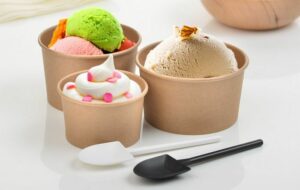
The Ultimate Guide To types of ice cream packaging (2023)
The Ultimate Guide To types of ice cream packaging (2023) Ready to dive into the sweet world of ice cream packaging? Today, In this guide,
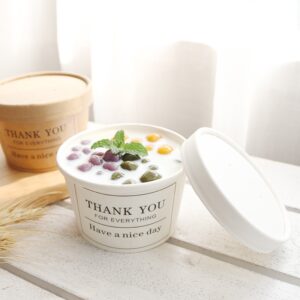
Can You Recycle Ice Cream Cartons?
Can You Recycle Ice Cream Cartons? In this article, I will share valuable information about ice cream carton recycling, including common types of materials used
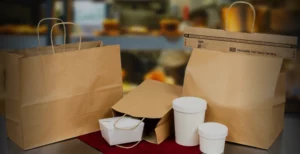
The Ultimate Guide To Food Delivery Packaging in 2023
The Ultimate Guide To Food Delivery Packaging in 2023 Today I will show you everything you need to know about food delivery packaging. In this
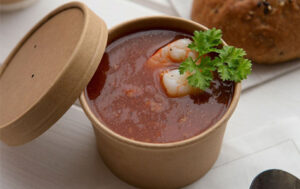
Best Disposable Bowl for Hot Soup:All You Need To Know (2023 Update)
Best Disposable Bowl for Hot Soup:All You Need To Know (2023 Update) What is the best disposable bowl for hot soup? In this article, you

2 Responses
We need the raw material for making the paper cup 🥤
Paper Lamination with Aluminium Foil Film
contact us